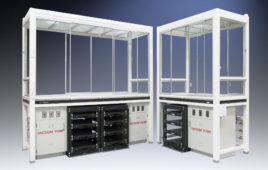Simply stated, nanotechnology is a system of innovative methods to control and manipulate matter at near atomic scale to produce new materials, structures, and devices. Manufacturers across the board are embracing the technology, coined nanomanufacturing, and the process is creeping up everywhere. Nanomanufactured materials can today be found in everything from auto bumpers that are 60% lighter and more resistant to scratching than standard bumpers, to sunscreen, where nanoparticles absorb UV light, to nanostructured polymer films used to make vibrant computer, TV, and cell phone displays that consume less power.
Although nanomanufacturing is resulting in better, state-of-the-art products, it is still filled with a lot of unknowns, especially regarding exposure and worker safety. Environmental groups are raising concerns about potential toxicity since research studies have found that nanoparticles, thousands of times smaller than the diameter of a human hair, could spur peculiar biological reactions when inhaled or absorbed through the skin in high concentrations.
In addition, nanomaterials also present a safety concern for potential fire and explosion. Studies show that decreasing the particle size of already combustible materials may increase the risk for explosion, and even though the explosion risk appears to plateau on order of 10 microns for many dust particles, some nanomaterials are designed specifically to generate heat through the progression of reactions at the nanoscale, presenting a fire hazard that is unique to engineered nanomaterials.
Workers may be exposed to these dangers during many phases of the manufacturing process, including packaging, transfer, and cleaning of the products containing nanoscale materials, thus making safety the utmost importance. Despite these concerns, government standards for the industry do not currently exist, but many organizations, including the National Institute for Occupational Health & Safety, have developed precautionary measures to decrease or eliminate potential risks, and incorporating vacuums with HEPA filters into maintenance plans is a common theme.
From: “Far From Nano: Hepa-Filtered Industrial Vacuums Help Solve Critical Safety Concerns”




